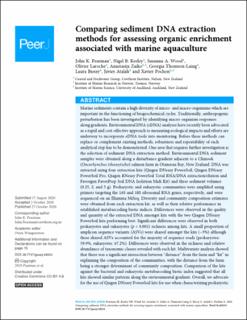| dc.description.abstract | Marine sediments contain a high diversity of micro- and macro-organisms which are important in the functioning of biogeochemical cycles. Traditionally, anthropogenic perturbation has been investigated by identifying macro-organism responses along gradients. Environmental DNA (eDNA) analyses have recently been advocated as a rapid and cost-effective approach to measuring ecological impacts and efforts are underway to incorporate eDNA tools into monitoring. Before these methods can replace or complement existing methods, robustness and repeatability of each analytical step has to be demonstrated. One area that requires further investigation is the selection of sediment DNA extraction method. Environmental DNA sediment samples were obtained along a disturbance gradient adjacent to a Chinook (Oncorhynchus tshawytscha) salmon farm in Otanerau Bay, New Zealand. DNA was extracted using four extraction kits (Qiagen DNeasy PowerSoil, Qiagen DNeasy PowerSoil Pro, Qiagen RNeasy PowerSoil Total RNA/DNA extraction/elution and Favorgen FavorPrep Soil DNA Isolation Midi Kit) and three sediment volumes (0.25, 2, and 5 g). Prokaryotic and eukaryotic communities were amplified using primers targeting the 16S and 18S ribosomal RNA genes, respectively, and were sequenced on an Illumina MiSeq. Diversity and community composition estimates were obtained from each extraction kit, as well as their relative performance in established metabarcoding biotic indices. Differences were observed in the quality and quantity of the extracted DNA amongst kits with the two Qiagen DNeasy PowerSoil kits performing best. Significant differences were observed in both prokaryotes and eukaryotes (p < 0.001) richness among kits. A small proportion of amplicon sequence variants (ASVs) were shared amongst the kits (~3%) although these shared ASVs accounted for the majority of sequence reads (prokaryotes: 59.9%, eukaryotes: 67.2%). Differences were observed in the richness and relative abundance of taxonomic classes revealed with each kit. Multivariate analysis showed that there was a significant interaction between “distance” from the farm and “kit” in explaining the composition of the communities, with the distance from the farm being a stronger determinant of community composition. Comparison of the kits against the bacterial and eukaryotic metabarcoding biotic index suggested that all kits showed similar patterns along the environmental gradient. Overall, we advocate for the use of Qiagen DNeasy PowerSoil kits for use when characterizing prokaryotic and eukaryotic eDNA from marine farm sediments. We base this conclusion on the higher DNA quality values and richness achieved with these kits compared to the other kits/amounts investigated in this study. The additional advantage of the PowerSoil Kits is that DNA extractions can be performed using an extractor robot, offering additional standardization and reproducibility of results. | en_US |
